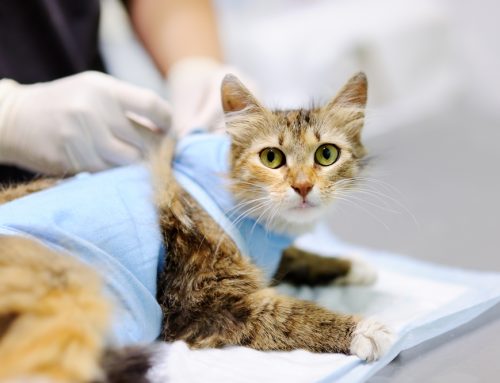Numerous pets are poisoned every year, and these incidents can have life-threatening consequences. Many poisonings are caused by common household substances that you use on a daily basis. Our team at El Paso Animal Hospital wants to help protect your pet by providing information on places in your home where pet toxins are frequently found.
#1: Your kitchen may contain pet toxins
Any human food can lead to gastrointestinal upset in pets, but certain foods are toxic, and can cause serious health issues.
- Grapes — Grapes, raisins, and currants contain a toxin that leads to kidney failure in pets. The cause is unclear, but recent findings suggest the toxin may be tartaric acid. Affected pets exhibit signs including vomiting, diarrhea, lethargy, and excessive thirst and urination.
- Onions — While your pet is unlikely to ingest a piece of raw onion, any food containing onions, garlic, leeks, shallots, chives, garlic powder, or onion powder can cause problems for your pet. These vegetables contain N-propyl disulphide, a toxin that can damage your pet’s red blood cells, leading to anemia. Initial signs include vomiting, diarrhea, lethargy, and loss of appetite. Anemia signs, which include pale mucous membranes, increased respiratory rate, lethargy, dark urine, and difficulty breathing, may take several days to manifest.
- Chocolate — Many pets find chocolate palatable, but this sweet treat contains two ingredients, theobromine and caffeine, that cause central nervous system and cardiac stimulation in pets. Negative effects depend on the dosage, the pet’s size, and the chocolate type ingested—for example, darker chocolate is more dangerous for pets than white or milk chocolate. Affected pets exhibit signs including nausea, vomiting, diarrhea, and increased thirst and urination. In severe cases, signs can progress to restlessness, cardiac arrhythmias, internal bleeding, seizures, and heart attack.
- Xylitol — This sugar substitute has many beneficial effects for humans, but causes a pet’s pancreas to release a dose-dependent amount of insulin, leading to hypoglycemia, and sometimes, acute liver failure. Affected pets exhibit signs including vomiting, weakness, incoordination, and seizures.
#2: Your medicine cabinet may contain pet toxins
Several over-the-counter (OTC) and prescription medications are toxic to pets.
- Acetaminophen — Acetaminophen toxicity is common in pets, with cats especially sensitive to this drug. Acetaminophen causes a decrease in the red blood cell’s ability to carry oxygen, causing signs including lethargy, rapid breathing, panting, and vomiting. Liver damage can also occur, causing jaundice, enlarged abdomen, and increased thirst and urination.
- Ibuprofen — Non steroidal anti-inflammatories work by blocking cyclooxygenase enzymes to decrease pain and inflammation, but these enzymes also play a role in maintaining the normal function of other body systems, such as the gastrointestinal tract, kidneys, and nervous system. Overdoses can lead to gastric or intestinal ulcerations, kidney failure, and neurological signs.
- Beta blockers — Beta blockers are commonly used in human and veterinary medicine to treat heart disease and regulate blood pressure, but these drugs have a narrow safety margin in pets. Overdoses can result in heart failure, severely low blood pressure, and acute kidney failure.
#3: Your garage may contain pet toxins
Your garage likely contains many substances toxic to pets, such as:
- Antifreeze — Many automotive antifreeze products contain ethylene glycol, which tastes sweet to pets. A small amount of ethylene glycol can severely damage your pet’s kidneys, resulting in kidney failure. Initial signs include vomiting, incoordination, excessive thirst and urination, and seizures.
- Motor oil — Motor oil has been touted as a cure for mange, but can damage your pet’s skin, and may be absorbed through their skin. In addition, many pets will attempt to lick the motor oil from their skin, which can lead to severe illness. Signs include vomiting, drooling, incoordination, increased respiratory rate, and coma.
- De-icers — Products such as rock salt and sidewalk salt that are used to de-ice your driveway are harmful to your pet’s skin and feet, and can cause significant problems if they ingest the substance while grooming. Signs include vomiting and lethargy, and, in severe cases, convulsions or kidney damage.
#4: Your supply closet may contain pet toxins
Many common household products are dangerous for pets.
- Batteries — If your pet ingests or chews on a battery, the alkaline or acidic material can leak, causing corrosive injuries to your pet’s mouth and gastrointestinal tract. Signs include drooling, vomiting, difficulty swallowing, and abdominal pain.
- Glue — Glues, such as wood, construction, and high-strength glues, are high risk for pets. If ingested, the glue mixes with the pet’s stomach fluids, and rapidly expands into a large, firm foreign body obstruction. Signs include drooling, vomiting, retching, and abdominal pain.
- Rat poison — Rodenticides are made to taste good to rodents, but they also taste good to your pet. Many rodenticide types are on the market, and all are extremely toxic to pets.
#5: Your garden may contain pet toxins

Many common plants, including tulips, lilies, azaleas, and chrysanthemums, are poisonous to pets. Other potential dangers in your garden include:
- Fertilizers — Many fertilizers can irritate your pet’s feet or skin, and these products can also be dangerous if ingested. Signs include lethargy, vomiting, and diarrhea.
- Herbicides and pesticides — These products can result in gastrointestinal upset in an exposed pet.
If your pet is exposed to any toxin, they need immediate veterinary attention. Contact El Paso Animal Hospital or Animal Poison Control as soon as possible, to ensure your pet quickly receives the care they need.







Leave A Comment